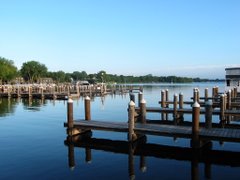syn-er-gy - combined effect being greater than parts. When the individual effects are negative, the combined effects are bad.
The underlying ecological principles that make aquatic invasive species (AIS) ‘bad’ for lakes are solid. Simply, AIS having come from somewhere else - from somewhere exotic – and are not constrained by the normal check and balances they encounter in their native waters. Thus, they often grow unfettered and create severe nuisances and ecological damage.
Two familiar examples are common carp and Eurasian watermilfoil. Common carp was intentionally introduced to the country over 100 years ago because of their high reproductive potential, their high protein quality and their popularity as food in Asian countries. While common carp have not become popular as a game fish or a food fish in Minnesota, their populations have exploded in Minnesota lakes and they have become a huge problem.
Likewise, milfoil, while not introduced intentionally, has also become a huge problem. Milfoil was first discovered in Minnesota (Lake Minnetonka) in 1987 and is now in over 200 lakes and continues to expand. In Lake Minnetonka, milfoil quickly expanded to the entire lake and now occupies between 3,000 and 5,000 acres. Unchecked, it forms dense mats and out-competes native plants causing nuisances and damage that include interfering with fishing, swimming and boating, the displacement of native plants, and the accumulation of nutrient-rich lake sediments.
We have practically no control methods for common carp and our controls for milfoil have, to-date, been limited to managing or mitigating some nuisance aspects. The harvesting program is designed to facilitate navigation and covers 300 to 500 acres per season. Individual lakeshore owners’ treatments are limited to small areas adjacent to their lakeshores. Most recently, the herbicide treatments in Grays and Phelps Bays offer promise for larger-scale, longer-term control.
We know carp and milfoil are bad - what happens as additional AIS are introduced into the lake?
This question must be contemplated as policies and programs are developed to prevent additional AIS. The Lake Minnetonka Association and others have focused much recent attention on zebra mussels that have been the AIS villain du jour. This makes sense as zebra mussels are the closest AIS to Lake Minnetonka and are likely to cause extreme damage.
In addition to the anticipated impacts of zebra mussel, we are concerned with synergistic effects. For example, we anticipate that should zebra mussel get into Lake Minnetonka, much of the lake water will be cleared through zebra mussel’s filtering action. This in turn will cause milfoil to expand its range by growing in deeper waters than at present.
There are other examples of synergistic impacts involving zebra mussels too. Zebra mussels facilitate avian botulism when round goby (another AIS) is in the lake. Thus, avian botulism has become problematic in lakes with both zebra mussel and round goby when it had not been a problem previously.
There are two points to make. First, while we usually cannot fully anticipate the full range of impacts of new AIS, we can expect there will be unanticipated impacts and enhanced impacts as new AIS are introduced into the lake. Second, all of the attention and effort that has been focused on single AIS (like zebra mussel) applies equally to additional AIS. And there are a couple dozen new AIS – plants, animals and viruses – nearing Lake Minnetonka. So, even if zebra mussel should be found in Lake Minnetonka, there is an ample and ongoing need to sustain our prevention efforts.
Synergistic effects of AIS boil down to: 1 + 1 = 3. The math may be bad, but so is AIS synergy.
We must remain vigilant and continue to invest in prevention programs, actions and funding. Lake Minnetonka remains highly exposed, so we have much more to do – Lake Minnetonka is too valuable.
Monday, July 13, 2009
Subscribe to:
Post Comments (Atom)


No comments:
Post a Comment